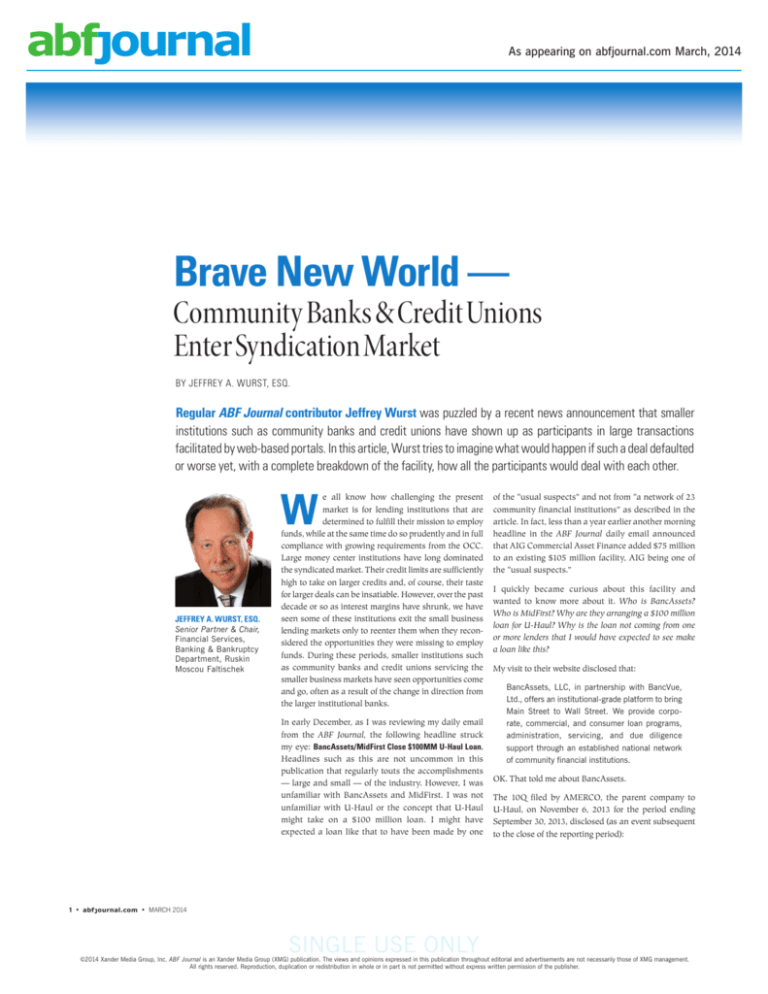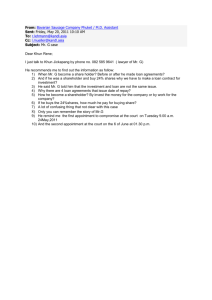
As appearing on abfjournal.com March, 2014
Brave New World —
Community Banks & Credit Unions
Enter Syndication Market
BY JEFFREY A. WURST, ESQ.
Regular ABF Journal contributor Jeffrey Wurst was puzzled by a recent news announcement that smaller
institutions such as community banks and credit unions have shown up as participants in large transactions
facilitated by web-based portals. In this article, Wurst tries to imagine what would happen if such a deal defaulted
or worse yet, with a complete breakdown of the facility, how all the participants would deal with each other.
W
JEFFREY A. WURST, ESQ.
Senior Partner & Chair,
Financial Services,
Banking & Bankruptcy
Department, Ruskin
Moscou Faltischek
e all know how challenging the present
market is for lending institutions that are
determined to fulfill their mission to employ
funds, while at the same time do so prudently and in full
compliance with growing requirements from the OCC.
Large money center institutions have long dominated
the syndicated market. Their credit limits are sufficiently
high to take on larger credits and, of course, their taste
for larger deals can be insatiable. However, over the past
decade or so as interest margins have shrunk, we have
seen some of these institutions exit the small business
lending markets only to reenter them when they reconsidered the opportunities they were missing to employ
funds. During these periods, smaller institutions such
as community banks and credit unions servicing the
smaller business markets have seen opportunities come
and go, often as a result of the change in direction from
the larger institutional banks.
In early December, as I was reviewing my daily email
from the ABF Journal, the following headline struck
my eye: BancAssets/MidFirst Close $100MM U-Haul Loan.
Headlines such as this are not uncommon in this
publication that regularly touts the accomplishments
— large and small — of the industry. However, I was
unfamiliar with BancAssets and MidFirst. I was not
unfamiliar with U-Haul or the concept that U-Haul
might take on a $100 million loan. I might have
expected a loan like that to have been made by one
of the “usual suspects” and not from “a network of 23
community financial institutions” as described in the
article. In fact, less than a year earlier another morning
headline in the ABF Journal daily email announced
that AIG Commercial Asset Finance added $75 million
to an existing $105 million facility, AIG being one of
the “usual suspects.”
I quickly became curious about this facility and
wanted to know more about it. Who is BancAssets?
Who is MidFirst? Why are they arranging a $100 million
loan for U-Haul? Why is the loan not coming from one
or more lenders that I would have expected to see make
a loan like this?
My visit to their website disclosed that:
BancAssets, LLC, in partnership with BancVue,
Ltd., offers an institutional-grade platform to bring
Main Street to Wall Street. We provide corporate, commercial, and consumer loan programs,
administration, servicing, and due diligence
support through an established national network
of community financial institutions.
OK. That told me about BancAssets.
The 10Q filed by AMERCO, the parent company to
U-Haul, on November 6, 2013 for the period ending
September 30, 2013, disclosed (as an event subsequent
to the close of the reporting period):
1 • abf Journal.com • MARCH 2014
SINGLE USE ONLY
©2014 Xander Media Group, Inc. ABF Journal is an Xander Media Group (XMG) publication. The views and opinions expressed in this publication throughout editorial and advertisements are not necessarily those of XMG management.
All rights reserved. Reproduction, duplication or redistribution in whole or in part is not permitted without express written permission of the publisher.
As appearing on abfjournal.com March, 2014
On October 8, 2013, various subsidiaries of AMERCO Real Estate
Company and U-Haul International, Inc. entered into a real estate
loan for $100 million. This loan matures in October 2016, with an
option to extend for four more years. This loan is secured by certain
properties owned by the borrowers. The interest rate for this loan is
the applicable LIBOR, plus an applicable margin of 2.50%.
The loan agreement was not attached to the filing so we will need to
wait until the 10K is filed to see how this loan, made by “23 community
financial institutions” with an average exposure of less than $5 million
each, was structured.
According to a December 3, 2013 article in the Credit Union Times,
the loan was made by four credit unions and 19 banks as follows:
Alliance Bank of Arizona; Atlantic Regional FCU in Brunswick, ME;
Bankers Trust Co.; Blue Ridge Bank; City National Bank of New Jersey;
Cross Keys Bank; ESB Financial, EVB; First Chatham Bank; Kennett
National Bank; Leaders Credit Union in Jackson, TN; Metropolitan
Bank; MidFirst Bank; Mohave State Bank; Money One Federal
Credit Union in Largo, MD; Murphy-Wall State Bank and Trust Co.;
Sacramento Credit Union in Sacramento, CA; Southeast National
Bank; Sycamore Bank; Texas First Bank; The Brenham National Bank;
The Clay City Banking Co. and The First National Bank and Trust Co.
of Broken Arrow.
Recent articles that I have authored have addressed challenges facing
co-lenders in their dealings with agents in multi-lender transactions.
As a result, my imagination started to run afoul about what might
occur if what can’t go wrong, does go wrong and how this group of 23
might approach a workout situation?
Does MidFirst have the capability and experience to agent a deal
like this? What is the reporting methodology between the agent and
co-lenders? What is the mechanism for resolving disputes, if any, among
the co-lenders?
Based upon the very limited information contained in the 10K, it
appears that this is structured as a single advance facility and not as a
revolver as I had originally thought when I saw the initial announcement. Thus, the co-lenders may expect that they can sit back and collect
their share of return each month. Hopefully this will be the case.
Now please join me in imagining this loan as a revolver. Can it be done?
Can a group like this deal with daily or even weekly or monthly borrowing
base certificates, advances, collections and settling up? How? How would
they deal with defaulting lenders? How would they deal with covenant
defaults or worse yet, with a complete break down of the facility? How
would they deal with each other?
We all know how difficult it is to get a consensus in small club deals let
alone large multi-lender syndications. Imagine that conference room
when my theoretical $100 million revolver by 20 institutions goes into
default and the lenders are called to a meeting.
As you can see, I am fascinated with the concept created by
BancAssets. But they are not the only one with a platform bringing
parties together. The Receivables Exchange is another electronic
platform bringing together parties to financial transactions.
According to its website:
The Receivables Exchange [is an] electronic exchange for the sale
and purchase of accounts receivable. In association with NYSE
Euronext, [it] connects large corporate sellers of receivables with
diversified sources of liquidity, including banks, family offices and
asset management funds. Transactions over [The Receivables
Exchange] are structured to result in a “true sale” of the receivables, thus offering balance sheet benefits to sellers and attractive
risk-adjusted returns to buyers.
Sound like factoring? Well, maybe, but not exactly.
DealVector is another web-based portal. But instead of bringing
together funding sources and funding users, DealVector provides a
platform for investors to anonymously communicate with each other.
According to its website:
Participants in CDOs, CLOs, derivatives, hedge funds and other
alternative investments have no easy way to identify other parties
to their deals. This imposes large costs with respect to price
discovery, governance, consent solicitations, illiquid asset sourcing,
creditor class formation and many other common events requiring
communication among deal participants … DealVector provides a
confidential deal registry, secure online communication tools, and
a validated membership base that make it easy to answer the question “Who’s in my deal?”
So what is the take-away of all of this? We all know that we are living
in the most challenging time for financial institutions to responsibly
employ funds. We also know that as the bank regulators continue
to tighten the reins on how regulated institutions may employ their
funds, competition increases from non-regulated sources for funding.
The internet has created opportunities that enhance this competition.
At the risk of giving away my age (do I really care?), I must confess
that although I have jumped into and have welcomed the new
opportunities created from the web, as an attorney, I remain very
traditional in approaching the structure and administration of
financial transactions.
So, for those entering this Brave New World of finance — Caveat
Emptor! (Buyer beware.) abfj
JEFFREY A. WURST, ESQ., is a senior partner and the chair of the
Financial Services, Banking & Bankruptcy Department at Ruskin Moscou
Faltischek, P.C., Uniondale, NY. He can be reached at (516) 663-6535
or at jwurst@rmfpc.com.
MARCH 2014 • abf Journal.com • 2
SINGLE USE ONLY
©2014 Xander Media Group, Inc. ABF Journal is an Xander Media Group (XMG) publication. The views and opinions expressed in this publication throughout editorial and advertisements are not necessarily those of XMG management.
All rights reserved. Reproduction, duplication or redistribution in whole or in part is not permitted without express written permission of the publisher.







